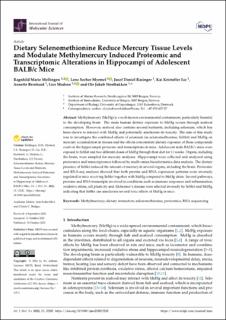Dietary selenomethionine reduce mercury tissue levels and modulate methylmercury induced proteomic and transcriptomic alterations in hippocampi of adolescent BALB/c mice
Mellingen, Ragnhild Marie; Myrmel, Lene Secher; Rasinger, Josef; Lie, Kai Kristoffer; Bernhard, Annette; Madsen, Lise; Nøstbakken, Ole Jakob
Peer reviewed, Journal article
Published version
Permanent lenke
https://hdl.handle.net/11250/3033069Utgivelsesdato
2022Metadata
Vis full innførselSamlinger
- Articles [3012]
- Publikasjoner fra CRIStin [3066]
Originalversjon
International Journal of Molecular Sciences. 2022, 23:12242 (20), 1-19. 10.3390/ijms232012242Sammendrag
Methylmercury (MeHg) is a well-known environmental contaminant, particularly harmful to the developing brain. The main human dietary exposure to MeHg occurs through seafood consumption. However, seafood also contains several nutrients, including selenium, which has been shown to interact with MeHg and potentially ameliorate its toxicity. The aim of this study was to investigate the combined effects of selenium (as selenomethionine; SeMet) and MeHg on mercury accumulation in tissues and the effects concomitant dietary exposure of these compounds exert on the hippocampal proteome and transcriptome in mice. Adolescent male BALB/c mice were exposed to SeMet and two different doses of MeHg through their diet for 11 weeks. Organs, including the brain, were sampled for mercury analyses. Hippocampi were collected and analyzed using proteomics and transcriptomics followed by multi-omics bioinformatics data analysis. The dietary presence of SeMet reduced the amount of mercury in several organs, including the brain. Proteomic and RNA-seq analyses showed that both protein and RNA expression patterns were inversely regulated in mice receiving SeMet together with MeHg compared to MeHg alone. Several pathways, proteins and RNA transcripts involved in conditions such as immune responses and inflammation, oxidative stress, cell plasticity and Alzheimer’s disease were affected inversely by SeMet and MeHg, indicating that SeMet can ameliorate several toxic effects of MeHg in mice.
